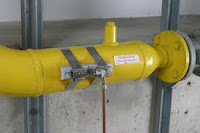 |
| A pipeline connected to the earthing grid |
Equipotential bonding refers to the maintenance of all metallic objects in a vicinity in the same potential. It is a widely followed practice in earthing. Equipotential bonding ensures that all metallic objects are at the ground potential. This eliminates the risk of shock occurring when someone accidentally comes in contact with objects at different potential. An area where all the objects are kept at the ground potential is called the earthed equipotential zone.
For instance, in a building there are many metallic fittings which are not part of the electrical distribution system such as bathroom fittings, pipes, metallic supports, steel supports used during construction etc. Should these fittings become live due to a leak in an electric circuit, they can pose a danger of electrocution. Hence, it is important that all metallic objects are kept at the ground potential by connecting them to the earthing grid.
Pipes which are made of plastic or PVC need not be connected to the equipotential network. In areas, which are likely to be wet such as bathrooms, the fittings are usually connected by an additional link to the equipotential grid. This is known as supplementary bonding.
Electronic devices such as computers and telecom equipment sometimes have a separate earthing pit. This is unsafe as it permits the rise of potential between the main earthing grid and the separate electronic earthing pit in the event of lightning strike. This can result in damage to the equipment.
image courtesy : dehn.de
